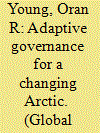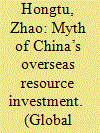|
|
|
Sort Order |
|
|
|
Items / Page
|
|
|
|
|
|
|
| Srl | Item |
| 1 |
ID:
135944


|
|
|
|
|
| Summary/Abstract |
The Arctic is a dynamic region. Conditions prevailing in the region today differ from those of yesterday in ways that have far-reaching consequences regarding needs for governance and the means of addressing them. There is every reason to expect that the Arctic of tomorrow will present a new array of needs for governance. It follows that effective governance in this region requires arrangements that are resilient in the sense that they are able to adapt to changing demands for governance over time without compromising their ability to solve problems in the present.[①] Taking this observation as a point of departure, I consider current and future needs for governance in the Arctic and assess the capacity of existing and emerging arrangements to meet these needs effectively. In the concluding section, I comment on the implications of these developments for the framing of policies relating to the Arctic on the part of China and other non-Arctic states.
|
|
|
|
|
|
|
|
|
|
|
|
|
|
|
|
| 2 |
ID:
135947


|
|
|
|
|
| Summary/Abstract |
The energy sector is an integral part of the ASEAN Economic Community (AEC). The AEC aims to transform ASEAN into a stable, secure, prosperous, rules-based, competitive, resilient, and integrated economic community by 2015.[①] The ASEAN Vision 2020[②] envisions a clean and green ASEAN with fully established mechanisms for sustainable development to ensure the protection of the environment, the sustainability of its natural resources, and a high quality of life for its people. Such a vision was incarnated at the Bali Summit in October 2003 as the AEC by 2020.[③] The adoption of the AEC Blueprint by the ASEAN Heads of State/Government in November 2007 expedited the implementation of the AEC to 2015.Energy is closely related to three of the four pillar under the AEC: energy commodities are products that will be freely moved in the “single market and production base” (pillar 1); a competitive energy sector is an indispensable part of “the competitive ASEAN” (pillar 2); and access to electricity is a key towards “equitable economic development” (pillar 3).[④]
|
|
|
|
|
|
|
|
|
|
|
|
|
|
|
|
| 3 |
ID:
135941


|
|
|
|
|
| Summary/Abstract |
Energy is more than an ordinary commodity ─ it has always acquired political attributes. Access to energy resources is an important factor for the political and economic development of a country. It not only lays a solid material foundation for the economic development of a country, but also helps to increase its comprehensive national strength and enables the country to pursue an independent foreign policy and to have extensive influence in international politics. Global energy security is crucial to economic growth and people’s livelihood in all countries. Energy is also fundamental to the prosperity and security of nations. The advent of globalization, the growing gap between the rich and poor, and the need to fight global warming are all intertwined with energy concerns. There is a pressing need for strategic thinking about the energy security.
|
|
|
|
|
|
|
|
|
|
|
|
|
|
|
|
| 4 |
ID:
135942


|
|
|
|
|
| Summary/Abstract |
The Second National Communication (SNC) on Climate Change of the People’s Republic of China was submitted to the Secretariat of the United Nations Framework Convention on Climate Change (UNFCCC, hereinafter referred to as the Convention) in November 2012[①] and was released to the international community. The second part of the communication was about China’s GHG inventory in 2005. This was the third time China officially released its GHG data after the release of GHG data of 1994 in Initial National Communication on Climate Change of the People’s Republic of China (INC) in 2004[②] and data of 2004 in National Climate Change Programme (NCCP) in 2007[③]. And this was also the first time China officially released the base year data after its 2020 CO2 mitigation target was announced in 2009 before the Copenhagen Conference, attracting wide attention from the international community.
|
|
|
|
|
|
|
|
|
|
|
|
|
|
|
|
| 5 |
ID:
135943


|
|
|
|
|
| Summary/Abstract |
As a political concept, preventive diplomacy may trace its origin back to the era of Cold War. It was first formally presented by the late UN Secretary-General Hammarskjöld, who opined that the aim of the preventive actions taken by the relevant agencies of the UN was to fill the power vacuum existing in the area outside the sphere of influence of the superpowers. “The United Nations enters the picture on the basis of its non-commitment to any power bloc, so as to provide to the extent possible a guarantee in relation to all parties against initiatives from others.”[①] Narrowly speaking, it just refers to the work on good offices, investigation, and mediation before further escalation or deterioration of the crises or conflicts, without any reference to the deployment of military troops. In contrast, preventive diplomacy in its extensive meaning not just includes the efforts made in the early period, but also covers the peacekeeping operations led or authorized by the UN. Under some circumstances it may also include the work on post-conflict peacebuilding. Former UN Secretary-General Boutros-Ghali also made a broad definition in his Agenda for Peace as “action to prevent disputes from arising between parties, to prevent existing disputes from escalating into conflicts and to limit the spread of the latter when they occur”.[②] That said, the focus of nowadays preventive diplomacy has changed greatly from earlier times. As interpreted by Mr. Hammarskjöld, the original intent is to prevent the superpowers of the Cold War from directly intervening into conflicts breaking out in the peripheral areas outside the sphere of influence of the two blocs, in case that they may lead to direct military confrontation between the superpowers. Later the preventive diplomacy advocated by western powers actually had strong sense of interference into domestic affairs of other countries, which became an instrument of legitimation for their actions to manipulate the changes in the internal political situations in small and medium countries.
|
|
|
|
|
|
|
|
|
|
|
|
|
|
|
|
| 6 |
ID:
135945


|
|
|
| 7 |
ID:
135946


|
|
|
|
|
| Summary/Abstract |
The recent phase of globalization is underlined by a clear “geopolitical shift” in favour of the developing world which has facilitated a recent spate of regionalization. A prominent feature of this “geopolitical shift” in the world system, resulting from the globalization of the world space in the last two decades is the emergence of a few developing states as economic powerhouses (China, India and Brazil). The post-cold-war period has seen a continuation of the relative shift of global economic power to the Asia-Pacific region (the recent currency “crisis” notwithstanding) and it is estimated that by 2020 four of the world’s five largest economies will be located in the region.[①] This complicates the conceptual clarity about the world political system, which was a feature of the Western discourse, as these economies challenge the traditional dominance of the industrialized states and new geographies take shape. The traditional division of the world into various spheres on the basis of levels of development viz. core-periphery, first world, third world, etc., now stands considerably altered. The emergence of China as the second largest economy of the world in recent years has defied the traditional notions of civilization, culture and development. This has led to a re-imagination of the world system which partly is a post-Cold-War situation wherein the bipolarity is missed and there exists an indication of a general momentum towards a multi-polar situation with regional groupings of states playing an ever increasing role in world politics. Overall, it is clear that the combination of globalisation with the “collapse” of bipolarity has ensured that regionalism and regionalisation will become increasingly important in world politics.[②] New regional formations are imagined which defy the logic of geography and are increasingly legitimized through constant repetition by statesmen, media and academic institutions. From the perspective of geopolitics these developments are significant for a number of reasons. Attempts to actively create and institutionalise regional entities represent an important moment in the politicisation of otherwise arbitrary geographic space.[③] Indo-Pacific is an example which by its expanse negates the traditional conceptions of “region”. This regionalization exercise holds relevance for India because of the reported Chinese presence in the Indian Ocean Region in the form of assistance in the construction of a number of ports in the region. Moreover, India has perceived the Indian Ocean space as the area of primary importance to them since the British times when the British designated it as a British lake. This imagination continued in the Indian strategic establishment even after independence from the British rule in the year 1947. It is significant to note that the British imagination of the Indian Ocean held value and tremendous imprint of the British navy till the year 1971 when the British forces withdrew from the East of Suez Canal. The Indian establishment for long held the British vision in the Indian Ocean.
|
|
|
|
|
|
|
|
|
|
|
|
|
|
|
|
| 8 |
ID:
135940


|
|
|
|
|
| Summary/Abstract |
China is sometimes accused of taking a “strategic approach” rather than a “market approach,” taking resources “off the market” and conducting a state-orchestrated, worldwide search for energy and resources. Some go even further to claim that international acquisition by China’s firms represents a national strategy which aims to use resource diplomacy to conceal its ambitions for strategic expansion. Simply stated, China’s overseas investment serves its foreign policy (more than its economic requirements).[1] These perceptions seem to derive from the fact that China’s overseas direct investment (ODI) is focused on natural resources, and is mostly conducted by state-owned enterprises (SOEs). The reality, however, is less sinister. China’s ODI reflects, and is an extension of, China’s domestic economic structure. The majority of Chinese firms involved in China’s domestic and overseas resource sectors are still SOEs, but their share is decreasing with the rapid market transition and decentralization occurring in China. China’s firms are mostly driven by profit motives and competitive pressure rather than energy security considerations or resource acquisition. The enterprises, rather than the government, generally initiate overseas resource investment decisions, although the government supports them to invest overseas.
|
|
|
|
|
|
|
|
|
|
|
|
|
|
|
|
|
|
|
|
|